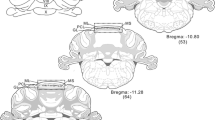Abstract
Mortality and occurrence of cholinergic symptoms upon sarin intoxication (144 µg/kg s.c., ~2×LD50) in rats is completely prevented by treatment with the adenosine A1 receptor agonist N 6-cyclopentyladenosine (CPA, 2 mg/kg i.m.). Previously, we have shown that CPA treatment altered the distribution of sarin into the brain, presumably through its cardiovascular side effects. Therefore, the objective of the present study was to evaluate the contribution of the cardiodepressant effects of CPA to its therapeutic efficacy against sarin intoxication. Intramuscular treatment of rats with 0.5 and 2.0 mg/kg CPA 1 min after sarin poisoning attenuated most cholinergic symptoms and prevented mortality, which seemed to be directly associated with an immediate strong and long-lasting bradycardia and hypotension caused by CPA. Treatment with lower doses of CPA (0.1 and 0.05 mg/kg i.m.) caused similar levels of bradycardia and hypotension, albeit a few minutes later than at the higher doses of CPA. Upon sarin intoxication, this was correlated with increased incidence of cholinergic symptoms and decreased survival rates. Pretreatment with the peripheral adenosine A1 receptor antagonist 8-p-sulphophenyltheophylline (8-PST, 20 mg/kg i.p.) counteracted the cardiodepressant effects of 0.05 mg/kg CPA almost completely, thereby nearly abolishing its therapeutic efficacy against sarin poisoning. In conclusion, the present results strongly indicate that bradycardia and hypotension induced by the peripheral adenosine A1 receptor play a prominent role in the therapeutic efficacy of CPA in cases of sarin poisoning.


Similar content being viewed by others
References
Brodie MS, Lee K, Fredholm BB, Stahle L, Dunwiddie TV (1987) Central versus peripheral mediation of responses to adenosine receptor agonists: evidence against a central mode of action. Brain Res 415:323–330
Bueters TJ, Groen B, Danhof M, IJzerman AP, Van Helden HP (2002) Therapeutic efficacy of the adenosine A1 receptor agonist N 6-cyclopentyladenosine (CPA) against organophosphate intoxication. Arch Toxicol 76:650–656
Bueters TJH, Joosen MJA, Van Helden HPM, IJzerman AP, Danhof M (2003) The adenosine A1 receptor agonist N 6-cyclopentyladenosine (CPA) affects the inactivation of acetylcholinesterase in blood and brain by sarin. J Pharmacol Exp Ther 304:1307–1313
Conti A, Monopoli A, Gamba M, Borea PA, Ongini E (1993) Effects of selective A1 and A2 adenosine receptor agonists on cardiovascular tissues. Naunyn Schmiedebergs Arch Pharmacol 348:108–112
Di Iorio P, Battaglia G, Ciccarelli, Ballerini P, Giuliani P, Poli A, Nicoletti F, Caciagli F (1996) Interaction between A1 adenosine and class II metabotropic glutamate receptors in the regulation of purine and glutamate release from rat hippocampal slices. J Neurochem 67:302–309
Dunwiddie TV (1999) Adenosine and suppression of seizures. Adv Neurol 79:1001–1010
Dunwiddie TV, Masino SA (2001) The role and regulation of adenosine in the central nervous system. Annu Rev Neurosci 24:31–55
Evoniuk G, von Borstel RW, Wurtman RJ (1987a) Antagonism of the cardiovascular effects of adenosine by caffeine or 8-(p-sulfophenyl)theophylline. J Pharmacol Exp Ther 240:428–432
Evoniuk G, Jacobson KA, Shamim MT, Daly JW, Wurtman RJ (1987b) A1- and A2-selective adenosine antagonists: in vivo characterization of cardiovascular effects. J Pharmacol Exp Ther 242:882–887
Finlayson K, Butcher SP, Sharkey J, Olverman HJ (1997) Detection of adenosine receptor antagonists in rat brain using a modified radioreceptor assay. Neurosci Methods 77:135–142
Fredholm BB, IJzerman AP, Jacobson KA, Klotz KN, Linden J (2001) International Union of Pharmacology. XXV. Nomenclature and classification of adenosine receptors. Pharmacol Rev 53:527–552
Gervitz LM, Lutherer LO, Hamilton ME, Fowler JC (2002) Lack of central effects of peripherally administered adenosine A1 agonists on synaptic transmission in the rat hippocampus. Brain Res 951:141–145
Gupta RC, Patterson GT, Dettbarn WD (1991) Comparison of cholinergic and neuromuscular toxicity following acute exposure to sarin and VX in rat. Fundam Appl Toxicol 16:449–458
Harrison PK, Bueters TJH, IJzerman AP, Van Helden HPM, Tattersall JEH (2003). Partial adenosine A1 receptor agonists inhibit sarin-induced epileptiform activity in the hippocampal slice. Eur J Pharmacol 471:97–104
Lallement G, Clarencon D, Masqueliez C, Baubichon D, Gallonier M, Burckhart MF, Peoc'h M, Mestries JC (1998) Nerve agent poisoning in primates: antilethal, anti-epileptic and neuroprotective effects of GK-11. Arch Toxicol 72:84–92
Marston HM, Finlayson K, Maemoto T, Olverman HJ, Akahane A, Sharkey J, Butcher SP (1998) Pharmacological characterization of a simple behavioral response mediated selectively by central adenosine A1 receptors, using in vivo and in vitro techniques. J Pharmacol Exp Ther 285:1023–1030
Mathôt RA, Van Schaick EA, Langemeijer MW, Soudijn W, Breimer DD, IJzerman AP and Danhof M (1994) Pharmacokinetic-pharmacodynamic relationship of the cardiovascular effects of adenosine A1 receptor agonist N 6-cyclopentyladenosine in the rat. J Pharmacol Exp Ther 268:616–624
Satoh Y, Hirashima N, Tokumaru H, Kirino Y (1997) Activation of adenosine A1 and A2 receptors differentially affects acetylcholine release from electric organ synaptosomes by modulating calcium channels. Neurosci Res 29:325–333
Shih TM, McDonough JH Jr (1997) Neurochemical mechanisms in soman-induced seizures. J Appl Toxicol 17:255–264
Simonato M, Varani K, Muzzolinni A, Bianchi C, Beani L, Borea PA (1994) Adenosine A1 receptors in the rat brain in the kindling model of epilepsy. Eur J Pharmacol 265:121–124
Van Helden HP, Bueters TJ (1999) Protective activity of adenosine receptor agonists in the treatment of organophosphate poisoning. Trends Pharmacol Sci 20:438–441
Van Helden HP, Busker RW, Melchers BP, Bruijnzeel PL (1996) Pharmacological effects of oximes: how relevant are they? Arch Toxicol 70:779–786
Van Helden HP, Groen B, Moor E, Westerink BH, Bruijnzeel PL (1998) New generic approach to the treatment of organophosphate poisoning: adenosine receptor mediated inhibition of ACh-rekease. Drug Chem Toxicol 21 [Suppl 1]:171–181
Author information
Authors and Affiliations
Corresponding author
Rights and permissions
About this article
Cite this article
Joosen, M.J.A., Bueters, T.J.H. & van Helden, H.P.M. Cardiovascular effects of the adenosine A1 receptor agonist N 6-cyclopentyladenosine (CPA) decisive for its therapeutic efficacy in sarin poisoning. Arch Toxicol 78, 34–39 (2004). https://doi.org/10.1007/s00204-003-0513-4
Received:
Accepted:
Published:
Issue Date:
DOI: https://doi.org/10.1007/s00204-003-0513-4




